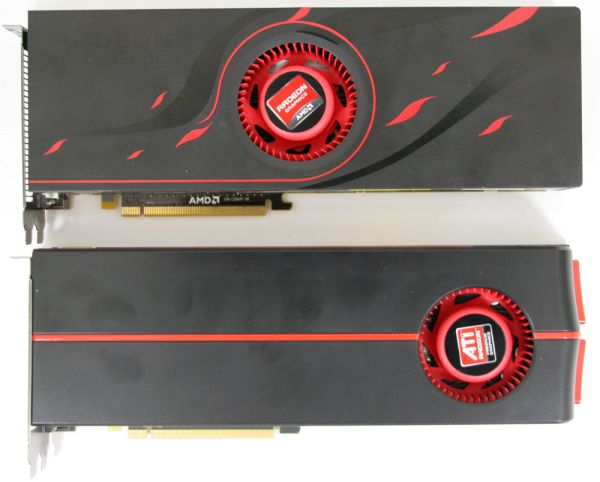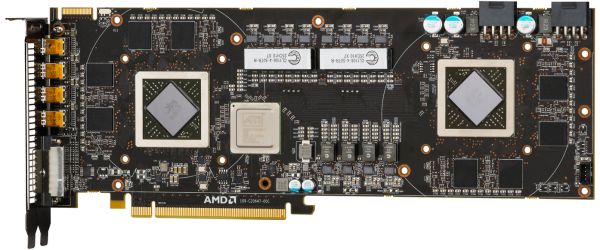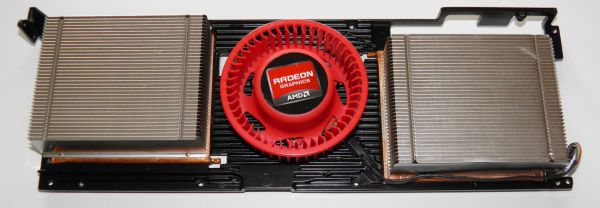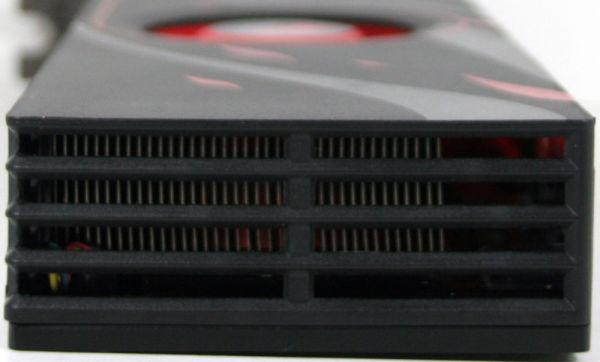AMD's Radeon HD 6990: The New Single Card King
by Ryan Smith on March 8, 2011 12:01 AM EST- Posted in
- AMD
- Radeon HD 6990
- GPUs
Meet The 6990
If you recall our coverage on the 5970, we found a few areas where AMD was lacking. The cooling on the 5970 was sufficient to run the GPUs even at 5870 clocks and voltages, however the cooling on the VRMs was lacking, leading to real world programs trigging the VRM thermal protection mechanism; and while this was within safety guidelines, it’s not a comfortable place to be for long term operation. This ultimately led to us writing off the 5970OC as a 100% reliable product, sticking to recommending the 5970 solely at stock speeds.
The design of the 6990 in turn reads very much like a response to our findings in true engineering fashion. Furthermore for the 6990 AMD not only had to take a look at the 5970’s weaknesses, but also how to handle an even greater power load. The result is that the 6990 is distinctly different from the 5970 before it.
Compared to the 5970, the 6990 is ever so slightly shorter, thanks in large part to the fact than the 6000 series casing is more squared off compared to the 5000 series’ tapered design. As a result it comes in at 11.5” for the PCB (the same as the 5970), and with casing a full 12” long compared to the 5970’s 12.16”. This means that the 6990 has effectively the same space requirements as the 5970, cooling notwithstanding.
Meanwhile it’s the fan however that is going to catch the most attention and this is where we’re going to dovetail in to cooling. The 5970’s traditional blower had its strengths and weaknesses, the strengths being that blowers are relatively forgiving about a case’s ability to exhaust hot air, and the weaknesses being that the GPU (and VRMs) closest to the fan received better cooling than the farther GPU. The VRMs proved to be particularly problematic, as they could overheat well before the GPUs did and AMD does not spin up their fans based on VRM temperatures.
Correcting for this and at the same time allowing for even greater heat dissipation, the rear blower design is out. Its replacement is a design that we’ve seen in 3rd party cards before such as the Asus ARES 5870X2, but not in a reference design: a center-mounted fan/blower with a GPU to each side. The difference is critical and indeed cannot be understated: a rear blower channels most hot air outside of the case, while a center-mounted blower effectively splits the card in two, with one GPU + supporting chips being exhausted outside of the case, and the 2nd GPU + supporting chips being exhausted inside the case. The design is still enclosed, so everything goes out either the front or back of the card while fresh air is pulled in the center.
With the replacement of the blower, so has gone the heatsink. The 5970’s single large vapor chamber + heatsink design has been replaced in favor of a segmented heatsink, further driving home the concept that the 6990 is closer to 2 video cards sharing 1PCB than it is 2 GPUs on one card. Each heatsink in turn is connected to the GPU via its own vapor chamber, resulting in the GPUs being fully isolated from each other as far as cooling is concerned.
Even the thermal paste connecting the GPUs to the vapor chambers has been changed for the 6990 – AMD has replaced traditional paste with a phase change material. Phase change materials – pastes/pads of material that melt and solidify based on temperature are nothing new, however they’re still exotic; material similar to what AMD is using is not readily available as paste is. AMD even went so far as to suggest that reviewers not directly disassemble their 6990s as it would require a new application of phase change paste in order to achieve the same efficiency as the original material. The net result of all of this by AMD’s numbers is that the phase change material is 8% better than the regular paste they’ve been using.
Rounding out our focus on cooling is the VRMs, which have been relocated in order to correct for the 5970’s limited VRM cooling capabilities. The VRMs and controllers are now at the center of the board – now they’re cooled before the GPUs or RAM modules are. The profoundness of this is twofold: not only is it an improvement on the 5970, but with the 6990’s higher power consumption VRM cooling is even more important. As with the 6970, voltage regulation is supplied by Volterra MOSFETs and controllers.
All told, while the 5970 was designed to handle and dissipate 400W of heat, the 6990 is officially designed for 450W. In practice, at its limits in our test rig this is closer to 500W. To handle and dissipate that much heat in roughly 72in3 of space is nothing short of amazing.


















130 Comments
View All Comments
MarkLuvsCS - Tuesday, March 8, 2011 - link
Thanks for an awesome article!Minor typo in section "ONCE AGAIN THE CARD THEY BEG YOU TO OVERCLOCK" second to last paragraph second sentence says "...the 6690OC’s core clock is only 6% faster and the memory clock is the same, versus..."
Figaro56 - Tuesday, March 8, 2011 - link
Yes this is the article I as waiting for. Time to get rid of my 2 HD 5870 cards and purchase 2 HD 6970 ones. I wouldn't get an HD 6990. That is pretty clear.Thanks AnAndTech!
mino - Tuesday, March 8, 2011 - link
AT has CHOSEN to not overclock the card based on its THEORETHICAL (Furmark) load temperatures ...Go bash AT for writing "OC" on the slides while they enabled ONLY the performance BIOS. Not doing ANY overclocking whatsoever by fear of Furmark ...
In effect what they have done was in effect a factory OC, not a traditional OC of the what-it-can-handle kind.
Great, so Furmark has achieved one more evil goal: it prevents (AT?) journalists to do overclocking reviews ...
mino - Tuesday, March 8, 2011 - link
Here come some real OC numbers: www.legitreviews.com/article/1566/14BTW, they did not even bother with the #1 BIOS option to achieve it ... so, lets talk about biased reviewing, shall we?
RaistlinZ - Tuesday, March 8, 2011 - link
Looks like the 2x6950 is a much better option, given you'll have much less noise to deal with and that they can be flashed to 6970 shaders.If this card had been $599 I probably would have picked one up. But at $699 I think I'll just wait for 28nm generation of cards.
Thanks for trying, AMD.
MarcHFR - Tuesday, March 8, 2011 - link
Hi,Drivers used are :
NVIDIA ForceWare 262.99
NVIDIA ForceWare 266.56 Beta
NVIDIA ForceWare 266.58
AMD Catalyst 10.10e
AMD Catalyst 11.1a Hotfix
AMD Catalyst 11.4 Preview
Is it possible to know wich driver is used for each card ?
Thanks
jcandle - Tuesday, March 8, 2011 - link
Ryan, any chance you'll be doing a thermal compound review soon? 8% against their stock compound. How much better is it than current performance aftermarket compounds?IanCutress - Tuesday, March 8, 2011 - link
Quite difficult to get accurate thermal compound numbers. There's no way you can guarantee that the compound will be spread evenly and accurately every time. Any big 8ºC differences will show sure, but you're always playing with statistics to +/- 3ºC. Then there's the inevitable argument about the right way to apply the paste...7Enigma - Tuesday, March 8, 2011 - link
More importantly is the normal compound most manufacturers use is junk compared to a good thermal compound such as arctic silver (don't keep up on the latest brands as I still have Arctic Silver 3 that works great for me). So that 8% might very well be true since the normal stuff is of poor quality.ypsylon - Tuesday, March 8, 2011 - link
But few issues need to be addressed. Noise for starters, nearly 80dBA. Thats like working in a foundry. Also cooling is highly inefficient for card of this size. Need some 3rd party solution or water cooling altogether.Biggest problem for 6990 could be (or rather will be) nVidia. If they price GTX590 at the same level or even below $700 price tag then AMD will be screwed totally. For now waiting for GTX590 and 6990 with some after market coolers as stock solutions are completely unacceptable.
One thing straight - I do not sleep on ca$h and if I buy 6990/590 it will be ma$$ive expense for me, but... What swings things for me with cards like this, is that I do not need uber VGA for 30 monitors. All I want is card with large frame buffer, which will live in my PC for ~10 years without need to upgrade, and it will occupy only 1 PCI-ex x16 slot. SLI/CF is totally misguided if you do have some more hardware installed inside. Sometimes (with all that SLI/CF popularity) I wonder, why 7 slot ATX is still alive and 10-12 slot motherboards are not a standard?